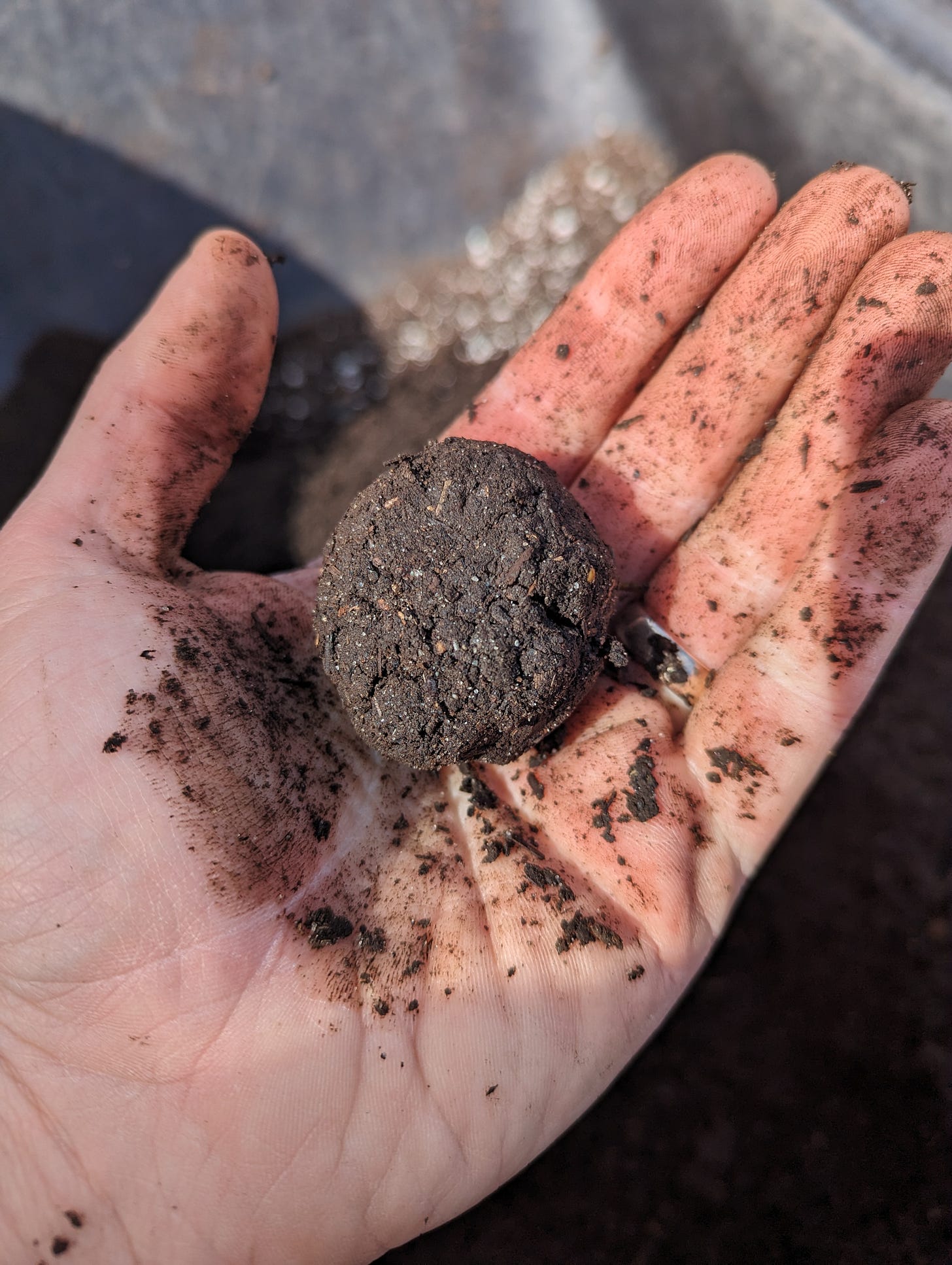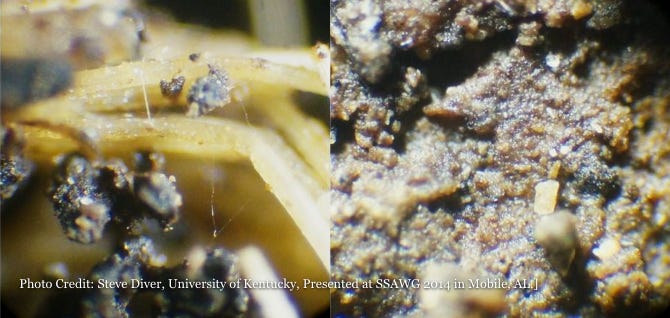It’s June. Plants are growing tall -- and so are the weeds. There can be the temptation to pull the weeds and drop them in the paths, letting them dry out in the sun. But there is a much more profitable use for these: to collect these precious weeds and add them to our compost piles.
Compost is at the heart of fertility in the garden. Debris from the entire farm is brought together and allowed to age, especially ruminant manures. As Rudolf Steiner suggested, the purpose of manuring is to enliven the soil. Similarly, Paracelsian alchemist and father of agricultural chemistry, Wallerius, suggested that the purpose of fertilizing is to “fatten” the soil. To demonstrate the combustible value of various manures, Wallerius undertook the undoubtedly odiferous task of distilling manure from different animals to find that enriching quality that might impart life to the soil.
In general, we tend to compost things like vegetables that are too far gone or weeds in their leafy stage. It seems somewhat unusual to consider aromatic flowers as candidates for a compost pile. If they are beautiful, they tend to stay in the field or are cut for bouquets or even dried as medicinal herbs, but how often do we intentionally add back these aromatic etheric oils to our compost?
This leads us to an aspect of how the biodynamic preparations help to enrich compost. It is not that these are forces of decomposition. No, as Alex Podolinsky reminds us, these biodynamic preparations are not forces of degeneration but rather “etheric formative forces” -- specifically, the biodynamic preparations contain the power to build up new life, not primarily to break down organic matter.
The story of the biodynamic preparations themselves is perhaps for another time, but, in short, most of the preparations have a floral quality. One thing that’s fairly easy to recognize is that aromatic essential oils from flowers have a tendency to diffuse upward and outward. How, then, do we bring them to the soil? Spraying essential oils over the garden is not enough -- most of their power would waft away. Instead, we have to find a way to get these dynamic qualities to settle down enough that we can introduce them to the soil. In short, biodynamics systematically introduces the aromatic floral element from the reproductive pole and introduces it to the head pole at the root of the plant. Steiner himself suggests that the brain is like a highly developed compost pile in the Agriculture Course. While each herbal preparation participates in this process, this tendency is exemplified in Valerian, whose greater concentration of oils accumulates not in the flower but in the root. The overall tendency of this one plant is the unifying impulse of all the biodynamic preparations. As Steiner suggests, Valerian is meant to be sprayed out over finished manure compost that is being spread (and incorporated) into the soil. If we imagine life as a sort of etheric fire -- and leaves perhaps as flames -- it is almost as if the woody debris in the field is like microcosmic logs of wood, good compost is rather like kindling, and the direct application of the essential oil of Valerian is somewhat like lighter fluid (or, if you prefer, ghee, as used in Agnihotra).
Image: the human being as a plant growing between the physical world and the spiritual world. Illustration © 2023 Stewart Lundy, All Rights Reserved. Used with permission.
Rudolf Steiner declined to speak about different methods of composting, instead relying on experimentation and modern science to sort that out. One good 21st-century method has proven to be the Johnson-Su bioreactor because it requires minimal turning which favors healthy fungal-dominant compost. In general, most garden plants with the exception of brassicas, rely on fungal associations. The air column maintained in the Johnson-Su bioreactor guarantees that the entire pile stays oxygenated.
Image: mostly ripened Johnson-Su compost (utilizing biodynamic preparations), not fully ripened yet
But even here, the Johnson-Su method was developed initially to help with surplus dairy cow manure. What are we putting in our compost pile? Leftovers from the garden, manure from the field. But manure is mostly digested leaves. Where are the etheric flowers? If we put in flowers, it is usually almost an afterthought: they’re crops or weeds going to seed that we have to remove. If we put medicinal herbs in the compost pile, it’s generally because they lost their quality for human use. But if we were serious about treating our compost piles as if they were living beings, shoudn’t we give the compost pile the same kinds of medicinal herbs we ourselves need? Give to the compost what you yourself need, and your compost becomes a form of medicine. This goes beyond the biodynamic preparations and approaches the idea of Hippocrates, “Let food be thy medicine and medicine be thy food.”
And so, we use the biodynamic compost preparations. These are inserted into the compost pile and, provided that it is kept moist, by the principle of radiation, the entire compost pile becomes embued with the qualities of those special medicinal herbs. Similarly, if you take a pinch of salt and put it in a glass of water, you don’t have one part of the water that is salty and another that is fresh -- by mere diffusion, the salt equalizes through the entire body of water. The properties of the preparations infuse themselves through the entire compost pile.
Image: Left: commercially produced compost; Right: fully transformed colloidal compost.
There is an economic concept called the Pareto Principle which says that about 80% of our value-creation derives from a mere 20% of our actual effort. On a farm, this might be seen in the fact that one product has a much better profit margin than most other items sold. In biodynamics, this principle also seems to apply. In her book Common-Sense Composting, Maye Bruce took the biodynamic herbs and experimented with her own compost starter using milk sugar (lactose), honey, and yarrow and stinging nettles. She found that most of the benefits to her compost came from singling yarrow and nettles out of the full set of preparations. She also found she was able to bypass using the biodynamic compost preparations by using fresh herbs, but she needed much larger quantities to get the same effect that the biodynamic compost preparations generate from tiny amounts.
Image: compost under a microscope. Left: unfinished parent material visible. Right: completely transformed colloidal humus
Alan Chadwick would recommend gathering weeds as you pick them in a bucket. For him, not far from Wallerius (fattening) or Steiner (enlivening), compost was about the special “moist gases” contained therein. Thus, weeds shouldn’t be allowed to dry out. You want to save their vitality by gathering them as you weed and piling them and watering the pile immediately. If we were to make the onerous process of weeding into not merely a necessary chore but an integral part of generating fertility on the farm, weeding would become a festival celebrating the farm as a living organism. It is a joy to take weeds from the garden, knowing their tenacity and vitality will make your compost all the better. It doesn’t hurt to know that garden weeds have a significantly greater concentration of key trace minerals than our domesticated crops. The best fertility comes from our weeds.
This is again why the biodynamic preparations bring so much to the compost: we are drawing from plants that thrive in the very ways we want our own plants to thrive in our gardens. The biodynamic preparations are drawn from indigenous plants, native to much of the entire world. If we want better crops and a healthier human future, it is in our best interest to make even better compost.









Malibu Compost sells the only bagged BD compost product I know of. It certainly has nice texture, but I was shocked to find out that Malibu actually brags about their long term composting process, which turns out to be 6months. Last time I checked (with Courtney), BD compost typically needed 2 years to finish (David Johnson asks for 1 to 2 years to finish his bioreactor compost, also. ) Am I being too doctrinaire assuming a definition of biodynamic compost making requires a two year period? (And, while I'm at it, please explain 'mineralized compost"' to me again (Not minerals added to compost as it's built but compost that has set too long and become 'mineralized') ) Thank you